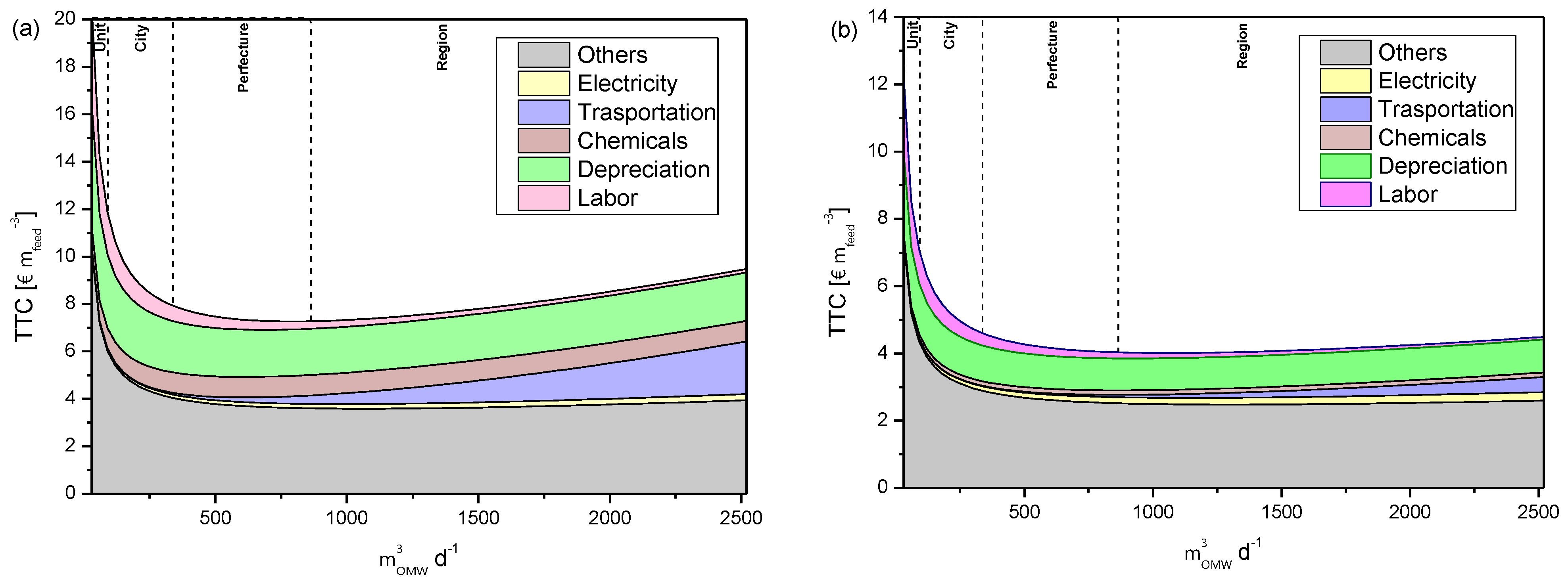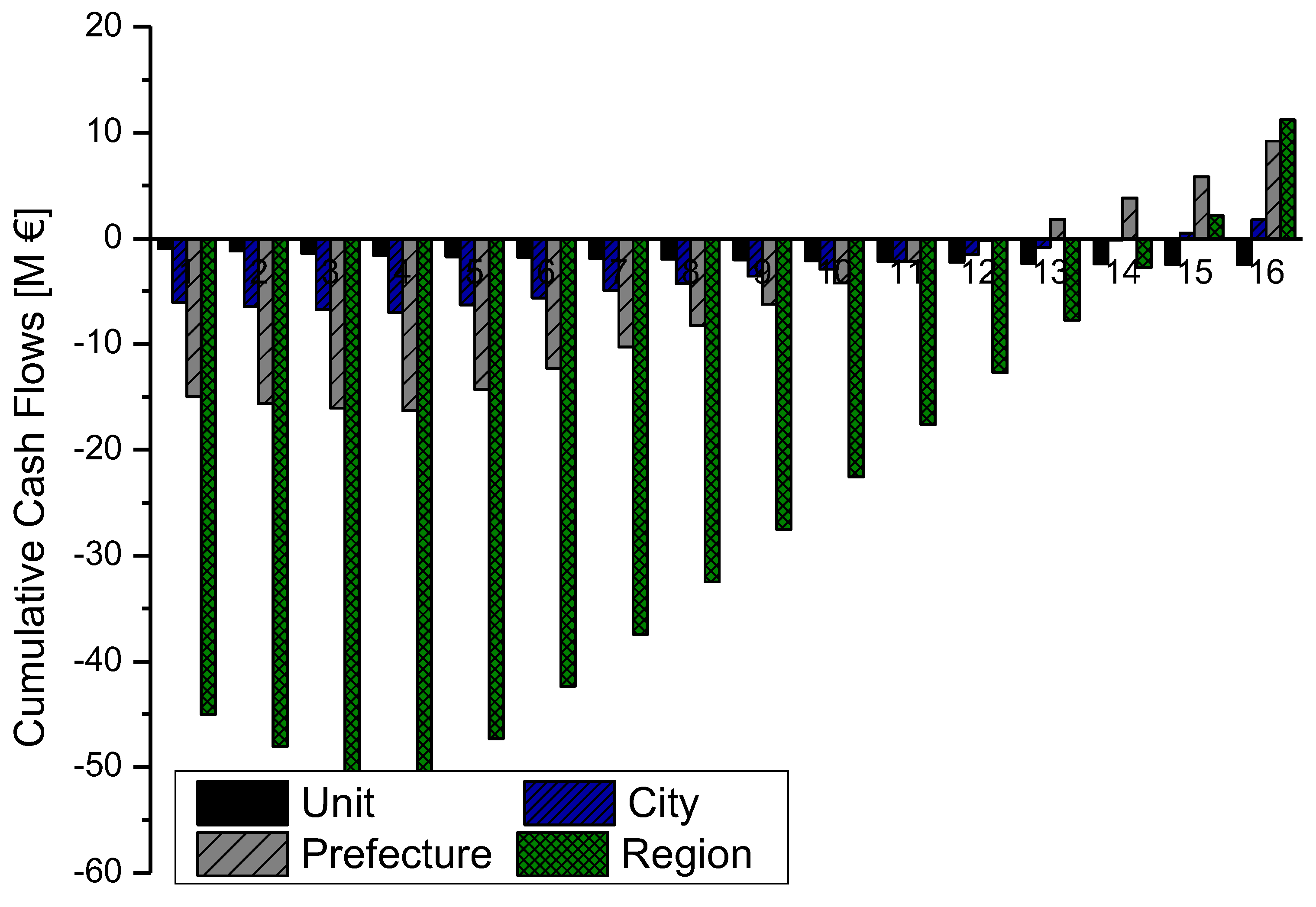Techno-Economic Assessment of Anaerobic Digestion for Olive Oil Industry Effluents in Greece
Abstract
:1. Introduction
2. Materials and Methods
3. Results & Discussion
3.1. Investment Plan Analysis
3.2. Sensitivity Analysis
4. Conclusions
Author Contributions
Funding
Institutional Review Board Statement
Informed Consent Statement
Data Availability Statement
Conflicts of Interest
Abbreviations
| CHP | Combined heat and power unit |
| COD | Chemical oxygen demand |
| FCI | Fixed capital investment |
| FVW | Fruit and vegetable waste |
| HRT | Hydraulic retention time |
| IRR | Internal rate of return |
| MARR | Minimum acceptable rate of return |
| NPV | Net present value |
| OLR | Organic loading rate |
| OMW | Olive mill wastewater |
| TTC | Total treatment cost |
References
- Varjani, S.; Upasani, V.N. Bioaugmentation of Pseudomonas Aeruginosa NCIM 5514–A Novel Oily Waste Degrader for Treatment of Petroleum Hydrocarbons. Bioresour. Technol. 2021, 319, 124240. [Google Scholar] [CrossRef]
- Cusenza, M.A.; Longo, S.; Cellura, M.; Guarino, F.; Messineo, A.; Mistretta, M.; Volpe, M. Environmental Assessment of a Waste-to-Energy Practice: The Pyrolysis of Agro-Industrial Biomass Residues. Sustain. Prod. Consum. 2021, 28, 866–876. [Google Scholar] [CrossRef]
- Chen, H.; Yang, T.; Shen, Z.; Yang, E.; Liu, K.; Wang, H.; Chen, J.; Sanjaya, E.H.; Wu, S. Can Digestate Recirculation Promote Biohythane Production from Two-Stage Co-Digestion of Rice Straw and Pig Manure? J. Environ. Manag. 2022, 319, 115655. [Google Scholar] [CrossRef]
- Koyande, A.K.; Chew, K.W.; Lim, J.-W.; Lam, M.-K.; Ho, Y.-C.; Show, P.-L. Biorefinery of Chlorella Sorokiniana Using Ultra Sonication Assisted Liquid Triphasic Flotation System. Bioresour. Technol. 2020, 303, 122931. [Google Scholar] [CrossRef]
- Surendra, K.C.; Takara, D.; Jasinski, J.; Kumar Khanal, S. Household Anaerobic Digester for Bioenergy Production in Developing Countries: Opportunities and Challenges. Environ. Technol. 2013, 34, 1671–1689. [Google Scholar] [CrossRef]
- Mohanty, S.S.; Koul, Y.; Varjani, S.; Pandey, A.; Ngo, H.H.; Chang, J.-S.; Wong, J.W.C.; Bui, X.-T. A Critical Review on Various Feedstocks as Sustainable Substrates for Biosurfactants Production: A Way towards Cleaner Production. Microb. Cell Fact. 2021, 20, 1–13. [Google Scholar] [CrossRef]
- Cowley, C.; Brorsen, B.W. Anaerobic Digester Production and Cost Functions. Ecol. Econ. 2018, 152, 347–357. [Google Scholar] [CrossRef]
- Mishra, B.; Varjani, S.; Agrawal, D.C.; Mandal, S.K.; Ngo, H.H.; Taherzadeh, M.J.; Chang, J.-S.; You, S.; Guo, W. Engineering Biocatalytic Material for the Remediation of Pollutants: A Comprehensive Review. Environ. Technol. Innov. 2020, 20, 101063. [Google Scholar] [CrossRef]
- European Commission. Roadmap 2050; European Commission: Brussels, Belgium, 2011. [Google Scholar]
- Parliament, E. Directive 2009/28/EC of the European Parliament and of the Council of 23 April 2009 on the Promotion of the Use of Energy from Renewable Sources and Amending and Subsequently Repealing Directives 2001/77/EC and 2003/30/EC. Off. J. Eur. Union L 2009, 140, 47. [Google Scholar]
- Orfanos, N.; Mitzelos, D.; Sagani, A.; Dedoussis, V. Life-Cycle Environmental Performance Assessment of Electricity Generation and Transmission Systems in Greece. Renew. Energy 2019, 139, 1447–1462. [Google Scholar] [CrossRef]
- Rekleitis, G.; Haralambous, K.-J.; Loizidou, M.; Aravossis, K. Utilization of Agricultural and Livestock Waste in Anaerobic Digestion (AD): Applying the Biorefinery Concept in a Circular Economy. Energies 2020, 13, 4428. [Google Scholar] [CrossRef]
- Prochaska, C.; Zouboulis, A. A Mini-Review of Urban Wastewater Treatment in Greece: History, Development and Future Challenges. Sustainability 2020, 12, 6133. [Google Scholar] [CrossRef]
- Alatzas, S.; Moustakas, K.; Malamis, D.; Vakalis, S. Biomass Potential from Agricultural Waste for Energetic Utilization in Greece. Energies 2019, 12, 1095. [Google Scholar] [CrossRef]
- Niaounakis, M.; Halvadakis, C.P. Olive Processing Waste Management: Literature Review and Patent Survey; Elsevier: Amsterdam, The Netherlands, 2006. [Google Scholar]
- Manthos, G.; Dareioti, M.; Zagklis, D.; Kornaros, M. Using Biochemical Methane Potential Results for the Economic Optimization of Continuous Anaerobic Digestion Systems: The Effect of Substrates’ Synergy. Renew. Energy 2023, 211, 296–306. [Google Scholar] [CrossRef]
- Sousa, D.A.; Costa, A.I.; Alexandre, M.R.; Prata, J.V. How an Environmental Issue Could Turn into Useful High-Valued Products: The Olive Mill Wastewater Case. Sci. Total Environ. 2019, 647, 1097–1105. [Google Scholar] [CrossRef]
- Al-Hmoud, L.; Al-Saida, B.; Sandouqa, A. Olive Mill Wastewater Treatment: A Recent Review. Jordanian J. Eng. Chem. Ind. 2020, 3, 91–106. [Google Scholar]
- Chauvel, A.; Fournier, G.; Raimbault, C. Manual of Process Economic Evaluation; Editions Technip: Paris France, 2003; ISBN 2710808366. [Google Scholar]
- Rani, P.; Mishra, A.R.; Krishankumar, R.; Ravichandran, K.S.; Kar, S. Multi-Criteria Food Waste Treatment Method Selection Using Single-Valued Neutrosophic-CRITIC-MULTIMOORA Framework. Appl. Soft Comput. 2021, 111, 107657. [Google Scholar] [CrossRef]
- Buchner, G.A.; Zimmermann, A.W.; Hohgräve, A.E.; Schomäcker, R. Techno-Economic Assessment Framework for the Chemical Industry—Based on Technology Readiness Levels. Ind. Eng. Chem. Res. 2018, 57, 8502–8517. [Google Scholar] [CrossRef]
- Jeronen, E. Economic Sustainability. In Encyclopedia of Sustainable Management; Springer: Berlin/Heidelberg, Germany, 2023; pp. 1257–1263. [Google Scholar]
- Tasionas, A.; Dounavis, A.S. Techno-Economic Analysis of the Olive Oil Mills Waste Valorisation for Energy Production: A Case Study of Corfu. Environ. Res. Eng. Manag. 2019, 75, 18–29. [Google Scholar] [CrossRef]
- Orive, M.; Cebrián, M.; Zufia, J. Techno-Economic Anaerobic Co-Digestion Feasibility Study for Two-Phase Olive Oil Mill Pomace and Pig Slurry. Renew. Energy 2016, 97, 532–540. [Google Scholar] [CrossRef]
- Manthos, G.; Zagklis, D.; Zafiri, C.; Kornaros, M. Comparative Life Cycle Assessment of Anaerobic Digestion, Lagoon Evaporation, and Direct Land Application of Olive Mill Wastewater. Bioresour. Technol. 2023, 388, 129778. [Google Scholar] [CrossRef]
- Manthos, G.; Zagklis, D.; Papavasileiou, V.; Gkountou, N.A.; Saita, Z.; Zafiri, C.; Kornaros, M. High-Rate Upflow Anaerobic Sludge Blanket Bioreactor for the Treatment of Olive Mill Effluents: Laboratory and Pilot Scale Systems Investigation. Renew. Energy 2023, 217, 119215. [Google Scholar] [CrossRef]
- Chen, H.; Yuan, J.; Xu, Q.; Yang, E.; Yang, T.; Shi, L.; Liu, Z.; Yu, H.; Cao, J.; Zhou, Q. Swine Wastewater Treatment Using Combined Up-Flow Anaerobic Sludge Blanket and Anaerobic Membrane Bioreactor: Performance and Microbial Community Diversity. Bioresour. Technol. 2023, 373, 128606. [Google Scholar] [CrossRef]
- Koszel, M.; Lorencowicz, E. Agricultural Use of Biogas Digestate as a Replacement Fertilizers. Agric. Agric. Sci. Procedia 2015, 7, 119–124. [Google Scholar] [CrossRef]
- Kookos, Ι. Introduction to Chemical Plant Design; Tziola Publishing: Glyfada, Greece, 2009; ISBN 978-960-418-173-5. [Google Scholar]
- Papadiamantopoulos, M. Design and Techno-Economic Optimization of an Energy Recovery Plant for Agroindustrial Waste. 2012. Available online: https://nemertes.library.upatras.gr/items/8ac84f07-1425-4619-99d6-9fc99617cd77 (accessed on 2 February 2024).
- Sitthikhankaew, R.; Predapitakkun, S.; Kiattikomol, R.W.; Pumhiran, S.; Assabumrungrat, S.; Laosiripojana, N. Comparative Study of Hydrogen Sulfide Adsorption by Using Alkaline Impregnated Activated Carbons for Hot Fuel Gas Purification. Energy Procedia 2011, 9, 15–24. [Google Scholar] [CrossRef]
- Lai, F.; Wang, S.; Liu, M.; Yan, J. Operation Optimization on the Large-Scale CHP Station Composed of Multiple CHP Units and a Thermocline Heat Storage Tank. Energy Convers. Manag. 2020, 211, 112767. [Google Scholar] [CrossRef]
- Peters, M.S.; Timmerhaus, K.D.; West, R.E. Plant Design and Economics for Chemical Engineers; McGraw-Hill: New York, NY, USA, 2003; Volume 4. [Google Scholar]
- Tsigkou, K.; Tsafrakidou, P.; Kopsahelis, A.; Zagklis, D.; Zafiri, C.; Kornaros, M. Used Disposable Nappies and Expired Food Products Valorisation through One-& Two-Stage Anaerobic Co-Digestion. Renew. Energy 2020, 147, 610–619. [Google Scholar]
- Mas Bolaños, M. Feasibility Study of Anaerobic Digestion of Olive Mill Wastewater for Energy Production. Case Study Applied to an Olive Oil Extraction Industry in Spain. Bachelor’s Thesis, Universitat Politècnica de Catalunya, Barcelona, Spain, 2017. [Google Scholar]
- Li, Y.; Han, Y.; Zhang, Y.; Luo, W.; Li, G. Anaerobic Digestion of Different Agricultural Wastes: A Techno-Economic Assessment. Bioresour. Technol. 2020, 315, 123836. [Google Scholar] [CrossRef]
- Aui, A.; Li, W.; Wright, M.M. Techno-Economic and Life Cycle Analysis of a Farm-Scale Anaerobic Digestion Plant in Iowa. Waste Manag. 2019, 89, 154–164. [Google Scholar] [CrossRef]
- de Diego-Díaz, B.; Peñas, F.J.; Fernández-Rodríguez, J. Sustainable Management of Lignocellulosic Wastes: Temperature Strategies for Anaerobic Digestion of Artichoke. J. Clean. Prod. 2021, 280, 124479. [Google Scholar] [CrossRef]
- Quiroz, M.; Varnero, M.T.; Cuevas, J.G.; Sierra, H. Cactus Pear (Opuntia Ficus-Indica) in Areas with Limited Rainfall for the Production of Biogas and Biofertilizer. J. Clean. Prod. 2021, 289, 125839. [Google Scholar] [CrossRef]






| Direct Costs, DC [EUR] | Onsite | Equipment cost | Cp |
| Installation cost | 0.06 FCI | ||
| Instrumentation and controls | 0.02 FCI | ||
| Piping | 0.04 FCI | ||
| Electrical equipment and materials | 0.02 FCI | ||
| Offsite | Buildings | 0.02 FCI | |
| Yard improvements | 0.02 FCI | ||
| Service facilities | 0.08 FCI | ||
| Land | 0.01 FCI | ||
| Indirect Costs, ΙC [EUR] | Engineering and supervision | 0.04 FCI | |
| Construction expenses | 0.04 FCI | ||
| Contactor’s fee | 0.02 FCI | ||
| Contingency | 0.05 FCI | ||
| Direct production costs, DPC (EUR/y) | Transportation | Crm,1 |
| NaHCO3 | Crm,2 | |
| Labor cost | Col | |
| Electricity | Crm,3 | |
| Operating supervision | 0.1 Col | |
| Maintenance and repairs | 0.02 FCI | |
| Operating supplies | 0.005 FCI | |
| Laboratory charges | 0.1 Col | |
| Royalties and patents | 0.01 FCI | |
| Depreciation | 0.07 Cp + 0.03 Cb | |
| Taxes | 0.03 FCI | |
| General expenses | 0.05 FCI | |
| General expenses, GE (EUR/y) | Administrative expenses | 0.02 TTC |
| Distribution and marketing expenses | 0.02 TTC | |
| Research and development | 0.05 TTC |
| Parameter | Units | OMW | FVW |
|---|---|---|---|
| COD | kg m−3 | 127 | 125 |
| OLR | kg COD m−3 d−1 | 5 | 1.54 |
| HRT | d−1 | 10 | 15 |
| Methane productivity | m3CH4 m−3feed | 11 | 9 |
| Parameter | Capacity | Value |
|---|---|---|
| IRR | Unit (30 m3 d−1) | 0% |
| NPV | −2.1 M € | |
| Payback Period | - | |
| IRR | City (300 m3 d−1) | 3% |
| NPV | −0.9 M € | |
| Payback Period | 14.2 years | |
| IRR | Prefecture (780 m3 d−1) | 6% |
| NPV | 1.1 Μ € | |
| Payback Period | 12 years | |
| IRR | Region (2300 m3 d−1) | 4% |
| NPV | −5.1 M € | |
| Payback Period | 13.9 years |
Disclaimer/Publisher’s Note: The statements, opinions and data contained in all publications are solely those of the individual author(s) and contributor(s) and not of MDPI and/or the editor(s). MDPI and/or the editor(s) disclaim responsibility for any injury to people or property resulting from any ideas, methods, instructions or products referred to in the content. |
© 2024 by the authors. Licensee MDPI, Basel, Switzerland. This article is an open access article distributed under the terms and conditions of the Creative Commons Attribution (CC BY) license (https://creativecommons.org/licenses/by/4.0/).
Share and Cite
Manthos, G.; Zagklis, D.; Zafiri, C.; Kornaros, M. Techno-Economic Assessment of Anaerobic Digestion for Olive Oil Industry Effluents in Greece. Sustainability 2024, 16, 1886. https://doi.org/10.3390/su16051886
Manthos G, Zagklis D, Zafiri C, Kornaros M. Techno-Economic Assessment of Anaerobic Digestion for Olive Oil Industry Effluents in Greece. Sustainability. 2024; 16(5):1886. https://doi.org/10.3390/su16051886
Chicago/Turabian StyleManthos, Georgios, Dimitris Zagklis, Constantina Zafiri, and Michael Kornaros. 2024. "Techno-Economic Assessment of Anaerobic Digestion for Olive Oil Industry Effluents in Greece" Sustainability 16, no. 5: 1886. https://doi.org/10.3390/su16051886
APA StyleManthos, G., Zagklis, D., Zafiri, C., & Kornaros, M. (2024). Techno-Economic Assessment of Anaerobic Digestion for Olive Oil Industry Effluents in Greece. Sustainability, 16(5), 1886. https://doi.org/10.3390/su16051886









